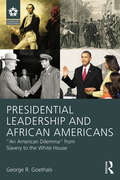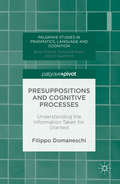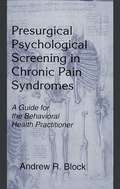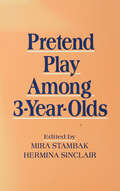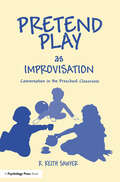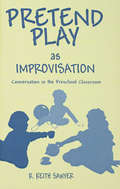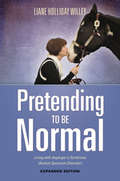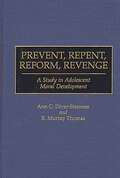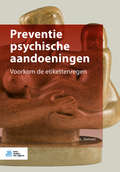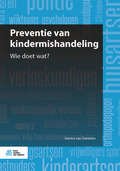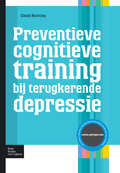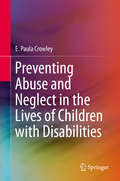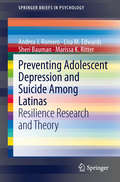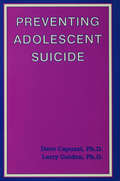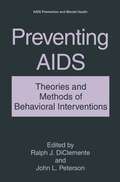- Table View
- List View
Presidential Leadership and African Americans: "An American Dilemma" from Slavery to the White House (Leadership: Research and Practice)
by George R. GoethalsPresidential Leadership and African Americans examines the leadership styles of eight American presidents and shows how the decisions made by each affected the lives and opportunities of the nation’s black citizens. Beginning with George Washington and concluding with the landmark election of Barack Obama, Goethals traces the evolving attitudes and morality that influenced the actions of each president on matters of race, and shows how their personal backgrounds as well as their individual historical, economic, and cultural contexts combined to shape their values, judgments, and decisions, and ultimately their leadership, regarding African Americans.
Presidential Leadership and African Americans: "An American Dilemma" from Slavery to the White House (Leadership: Research and Practice)
by George R. GoethalsPresidential Leadership and African Americans examines the leadership styles of eight American presidents and shows how the decisions made by each affected the lives and opportunities of the nation’s black citizens. Beginning with George Washington and concluding with the landmark election of Barack Obama, Goethals traces the evolving attitudes and morality that influenced the actions of each president on matters of race, and shows how their personal backgrounds as well as their individual historical, economic, and cultural contexts combined to shape their values, judgments, and decisions, and ultimately their leadership, regarding African Americans.
Presuppositions and Cognitive Processes: Understanding the Information Taken for Granted (Palgrave Studies in Pragmatics, Language and Cognition)
by Filippo DomaneschiThis book breaks new ground towards an understanding of the mental processes involved in presupposition, the comprehension of information taken for granted. Various psycholinguistic experiments are discussed to support the idea that involved in ordinary language comprehension are complex and demanding cognitive processes. The author demonstrates that these processes exist not only at the explicit level of an utterance but also at a deeper level of computing, where the background information taken for granted as already known and shared between interlocutors is processed. The author shows that experimental research can suggest new theoretical models for presupposition, thus this book will be of interest to researchers and students of psycholinguistics, the philosophy of language and experimental pragmatics.
Presurgical Psychological Screening in Chronic Pain Syndromes: A Guide for the Behavioral Health Practitioner
by Andrew R. BlockPain is an unfortunate daily experience for many individuals. Chronic pain -- lasting six or more months -- is suffered by approximately 30% of the population in the United States. These individuals wake up, function during the day and go to sleep, trying to keep pain at a minimum while, at the same time, maintaining some quality of life. They may make frequent visits to the doctor and the pharmacy. When they find relief, it is usually short-lived and comes at a cost such as dependence on narcotic medications or complete limitation of activity. Pain often becomes the central point of their existence. This practice guide describes an approach to psychological evaluation of the chronic pain patient who is being considered for surgery. A large body of research is accumulating which demonstrates that the outcome of surgical procedures aimed at chronic pain relief can be strongly influenced by psychological and emotional factors. This approach, termed "presurgical psychological screening" (PPS) uses interview and testing techniques to identify emotional, behavioral, and psychosocial difficulties which have been demonstrated to negatively impact surgical outcome. Studies show that even patients with clearly identifiable pathophysiology may respond poorly to surgery, due to issues such as pain sensitivity, medication dependence, rewards for pain behavior and personality style. Thus, some insurance carriers, rehabilitation nurses and state worker's compensation systems are encouraging, or even requiring, presurgical psychological screening in cases of surgery designed to relieve chronic pain. The first to present a comprehensive, unified approach to PPS in chronic pain syndromes, this text is designed to provide the behavioral health practitioner, as well as the trainee, with all the tools and information necessary to conduct PPS evaluations. It identifies a multitude of risk factors for poor surgical outcome and reviews research associated with each risk factor. Hands-on techniques for eliciting information from the patient about risk factors is also detailed. Toward this end, the practice guide also contains a number of forms and session outlines which can be directly utilized, or which can be altered to fit readers' needs. Models for weighing and combining surgical outcome risk factors are also provided. Thus, practitioners are able to reach valid and reliable predictions of surgical results. Finally, the text provides outlines of psychological interventions which can facilitate surgical outcome as well as surgical treatment alternatives. Upon completion of this practice guide, readers should be able to begin providing PPS evaluations which are scientifically valid, clinically sound, and which result in significant overall improvement in the treatment of chronic pain syndromes.
Presurgical Psychological Screening in Chronic Pain Syndromes: A Guide for the Behavioral Health Practitioner
by Andrew R. BlockPain is an unfortunate daily experience for many individuals. Chronic pain -- lasting six or more months -- is suffered by approximately 30% of the population in the United States. These individuals wake up, function during the day and go to sleep, trying to keep pain at a minimum while, at the same time, maintaining some quality of life. They may make frequent visits to the doctor and the pharmacy. When they find relief, it is usually short-lived and comes at a cost such as dependence on narcotic medications or complete limitation of activity. Pain often becomes the central point of their existence. This practice guide describes an approach to psychological evaluation of the chronic pain patient who is being considered for surgery. A large body of research is accumulating which demonstrates that the outcome of surgical procedures aimed at chronic pain relief can be strongly influenced by psychological and emotional factors. This approach, termed "presurgical psychological screening" (PPS) uses interview and testing techniques to identify emotional, behavioral, and psychosocial difficulties which have been demonstrated to negatively impact surgical outcome. Studies show that even patients with clearly identifiable pathophysiology may respond poorly to surgery, due to issues such as pain sensitivity, medication dependence, rewards for pain behavior and personality style. Thus, some insurance carriers, rehabilitation nurses and state worker's compensation systems are encouraging, or even requiring, presurgical psychological screening in cases of surgery designed to relieve chronic pain. The first to present a comprehensive, unified approach to PPS in chronic pain syndromes, this text is designed to provide the behavioral health practitioner, as well as the trainee, with all the tools and information necessary to conduct PPS evaluations. It identifies a multitude of risk factors for poor surgical outcome and reviews research associated with each risk factor. Hands-on techniques for eliciting information from the patient about risk factors is also detailed. Toward this end, the practice guide also contains a number of forms and session outlines which can be directly utilized, or which can be altered to fit readers' needs. Models for weighing and combining surgical outcome risk factors are also provided. Thus, practitioners are able to reach valid and reliable predictions of surgical results. Finally, the text provides outlines of psychological interventions which can facilitate surgical outcome as well as surgical treatment alternatives. Upon completion of this practice guide, readers should be able to begin providing PPS evaluations which are scientifically valid, clinically sound, and which result in significant overall improvement in the treatment of chronic pain syndromes.
Pretend Play Among 3-year-olds
by Hermina Sinclairtranslated by Hermina and Morris Sinclair This book was written by a group of researchers with a common theoretical-constructivist-framework and using the same methods of naturalistic observation and data analysis. They considered that collective pretend play would provide excellent opportunities for understanding young children's thinking, especially when play arose spontaneously in a familiar environment. In such play, children often manifest types of knowledge that cannot be captured through experimental work or by observation in adult-devised situations. Spontaneous play brings out children's own preoccupations, their know-how in negotiating with one another in order to make sustained play possible, their ability to construct coherent sequences, and their often surprising insight into adult behavior. Play sequences are reported in full and sometimes dramatic detail in each of the chapters. Different activities were elicited by different situations, though all were observed in the familiar environment of day-care centers. Different situations -- play with toys such as cups, spoons and dolls, with pieces of cloth, string and cardboard, with grass, pebbles and swings in the yard, or with hand-held puppets -- allow the authors to discover often unsuspected knowledge among three-year-olds: communicative, socio-affective, societal, and psycho-social. At the same time, the authors underline the similarity of the interactive construction processes. The data and their analyses provide a solid base for two of Piaget's theoretical arguments: peer interaction leads to collaborative processes at an early age, and collaboration leads to objective knowledge via the attribution of shared meanings to jointly constructed experiences.
Pretend Play Among 3-year-olds
by Hermina Sinclairtranslated by Hermina and Morris Sinclair This book was written by a group of researchers with a common theoretical-constructivist-framework and using the same methods of naturalistic observation and data analysis. They considered that collective pretend play would provide excellent opportunities for understanding young children's thinking, especially when play arose spontaneously in a familiar environment. In such play, children often manifest types of knowledge that cannot be captured through experimental work or by observation in adult-devised situations. Spontaneous play brings out children's own preoccupations, their know-how in negotiating with one another in order to make sustained play possible, their ability to construct coherent sequences, and their often surprising insight into adult behavior. Play sequences are reported in full and sometimes dramatic detail in each of the chapters. Different activities were elicited by different situations, though all were observed in the familiar environment of day-care centers. Different situations -- play with toys such as cups, spoons and dolls, with pieces of cloth, string and cardboard, with grass, pebbles and swings in the yard, or with hand-held puppets -- allow the authors to discover often unsuspected knowledge among three-year-olds: communicative, socio-affective, societal, and psycho-social. At the same time, the authors underline the similarity of the interactive construction processes. The data and their analyses provide a solid base for two of Piaget's theoretical arguments: peer interaction leads to collaborative processes at an early age, and collaboration leads to objective knowledge via the attribution of shared meanings to jointly constructed experiences.
Pretend Play As Improvisation: Conversation in the Preschool Classroom
by R. Keith SawyerEveryday conversations including gossip, boasting, flirting, teasing, and informative discussions are highly creative, improvised interactions. Children's play is also an important, often improvisational activity. One of the most improvisational games among 3- to 5-year-old children is social pretend play--also called fantasy play, sociodramatic play, or role play. Children's imaginations have free reign during pretend play. Conversations in these play episodes are far more improvisational than the average adult conversation. Because pretend play occurs in a dramatized, fantasy world, it is less constrained by social and physical reality. This book adds to our understanding of preschoolers' pretend play by examining it in the context of a theory of improvisational performance genres. This theory, derived from in-depth analyses of the implicit and explicit rules of theatrical improvisation, proves to generalize to pretend play as well. The two genres share several characteristics: * There is no script; they are created in the moment. * There are loose outlines of structure which guide the performance. * They are collective; no one person decides what will happen. Because group improvisational genres are collective and unscripted, improvisational creativity is a collective social process. The pretend play literature states that this improvisational behavior is most prevalent during the same years that many other social and cognitive skills are developing. Children between the ages of 3 and 5 begin to develop representations of their own and others' mental states as well as learn to represent and construct narratives. Freudian psychologists and other personality theorists have identified these years as critical in the development of the personality. The author believes that if we can demonstrate that children's improvisational abilities develop during these years--and that their fantasy improvisations become more complex and creative--it might suggest that these social skills are linked to the child's developing ability to improvise with other creative performers.
Pretend Play As Improvisation: Conversation in the Preschool Classroom
by R. Keith SawyerEveryday conversations including gossip, boasting, flirting, teasing, and informative discussions are highly creative, improvised interactions. Children's play is also an important, often improvisational activity. One of the most improvisational games among 3- to 5-year-old children is social pretend play--also called fantasy play, sociodramatic play, or role play. Children's imaginations have free reign during pretend play. Conversations in these play episodes are far more improvisational than the average adult conversation. Because pretend play occurs in a dramatized, fantasy world, it is less constrained by social and physical reality. This book adds to our understanding of preschoolers' pretend play by examining it in the context of a theory of improvisational performance genres. This theory, derived from in-depth analyses of the implicit and explicit rules of theatrical improvisation, proves to generalize to pretend play as well. The two genres share several characteristics: * There is no script; they are created in the moment. * There are loose outlines of structure which guide the performance. * They are collective; no one person decides what will happen. Because group improvisational genres are collective and unscripted, improvisational creativity is a collective social process. The pretend play literature states that this improvisational behavior is most prevalent during the same years that many other social and cognitive skills are developing. Children between the ages of 3 and 5 begin to develop representations of their own and others' mental states as well as learn to represent and construct narratives. Freudian psychologists and other personality theorists have identified these years as critical in the development of the personality. The author believes that if we can demonstrate that children's improvisational abilities develop during these years--and that their fantasy improvisations become more complex and creative--it might suggest that these social skills are linked to the child's developing ability to improvise with other creative performers.
Pretend the World Is Funny and Forever: A Psychological Analysis of Comedians, Clowns, and Actors
by S. Fisher R. L. FisherFirst published in 1982. Routledge is an imprint of Taylor & Francis, an informa company.
Pretend the World Is Funny and Forever: A Psychological Analysis of Comedians, Clowns, and Actors
by S. Fisher R. L. FisherFirst published in 1982. Routledge is an imprint of Taylor & Francis, an informa company.
Pretending to be Normal: Living with Asperger's Syndrome (Autism Spectrum Disorder) Expanded Edition
by Tony Attwood Liane Holliday WilleyCompelling and witty, Liane Holliday Willey's account of growing to adulthood as an undiagnosed 'Aspie' has been read by thousands of people on and off the autism spectrum since it was first published in 1999. Bringing her story up to date, including her diagnosis as an adult, and reflecting on the changes in attitude over 15 years, this expanded edition will continue to entertain (and inform) all those who would like to know a little more about how it feels to spend your life `pretending to be normal'.
Pretending to be Normal: Living with Asperger's Syndrome (Autism Spectrum Disorder) Expanded Edition (PDF)
by Liane Holliday Willey Tony AttwoodCompelling and witty, Liane Holliday Willey's account of growing to adulthood as an undiagnosed 'Aspie' has been read by thousands of people on and off the autism spectrum since it was first published in 1999. Bringing her story up to date, including her diagnosis as an adult, and reflecting on the changes in attitude over 15 years, this expanded edition will continue to entertain (and inform) all those who would like to know a little more about how it feels to spend your life `pretending to be normal'.
Prevenire gli eventi avversi nella pratica clinica
by Riccardo Tartaglia Andrea VannucciLa questione della sicurezza dei pazienti e del rischio clinico rappresenta da sempre un problema in medicina, ma è a partire dagli ultimi anni che essa è diventata un ambito prioritario della qualità nei servizi sanitari. La medicina non è una scienza esatta e le cure mediche non sono sempre efficaci e affidabili. La materia è inoltre così vasta e complessa da rendere impossibile agli operatori una conoscenza completa di ogni aspetto; a ciò si aggiunge il fatto che i pazienti non sempre si attengono correttamente alle indicazioni di terapia. La valutazione del rischio e l'analisi degli eventi avversi possono quindi contribuire ad accrescere i livelli di sicurezza degli assistiti, a ridurre l'inappropriatezza delle procedure e a impiegare meglio le risorse umane e tecnologiche. Questo volume, dopo una prima valutazione dello stato dell’arte della sicurezza del paziente in Italia e all’estero, presenta i metodi più diffusi per l’analisi degli eventi avversi nelle diverse specialità (medicina d’urgenza, ostetricia e ginecologia, oncologia, salute mentale, ecc.) e nei servizi di supporto (laboratori analisi, radiologia, trasfusioni, farmaceutica). Sono inoltre esaminati gli incidenti più frequenti in strutture extraospedaliere (come ambulatori di medicina generale, servizi sanitari delle carceri). Quest’opera, caratterizzata da una particolare vastità di argomenti trattati, descrive come contenere il rischio e prevenire gli eventi avversi in sanità, analizzando la natura dell’errore umano e applicando le pratiche di sicurezza più efficaci.
Prevent, Repent, Reform, Revenge: A Study in Adolescent Moral Development (International Contributions in Psychology)
by Ann Diver-Stamnes R. Murray ThomasPrevent, Repent, Reform, Revenge is a study of the aims that people intend to achieve by the sanctions and treatments they recommend for wrongdoers. The book is designed to answer two main questions: What kind of analytical scheme can profitably reveal the nature of people's reasoning about the aims of sanctions they propose for perpetrators of crimes and misdeeds? In the aims that people express what changes in overt moral reasoning patterns appear between later childhood and the early adult years? The authors conducted interviews with 136 youths between the ages of 9 and 21 to find out what sanctions and aims they felt were appropriate in three cases of wrongdoing. The resulting information provides an important insight into adolescent moral development.
Preventie psychische aandoeningen: Voorkom de etikettenregen
by J.J.L. DerksenDit boek geeft professionals in de geestelijke gezondheidszorg gereedschap om de zorg voor baby's, jongeren en ouders op zo'n manier te verbeteren dat ze bijdraagt aan het voorkomen van psychische aandoeningen. Op welke manier leiden onze stressvolle samenleving en het ontbreken van een gedeelde opvoedideologie tot het ontstaan van psychische aandoeningen? Het bevorderen van psychologische, psychomotorische en psychofysiologische stevigheid kan alleen bereikt worden als er vanaf de conceptie of misschien zelfs al daarvoor wordt ingezet op preventie. Preventie psychische aandoeningen begint daarom bij het moment waarop in de intieme relatie de wens opkomt een kind te krijgen. Alle ontwikkelingsstappen die hierna volgen worden aan de hand van wetenschappelijk onderzoek, theorievorming en klinische praktijkervaring onder de loep genomen. Hulpverleners worden voorzien van praktische handvatten en tips om een nieuwe werkwijze toe te passen in de praktijk. Prof. Dr. Jan Derksen (1953) studeerde journalistiek, psychologie, sociologie, filosofie en psychofarmacologie. Hij doceert psychodiagnostiek aan de Radboud Universiteit en is hoogleraar aan de Vrije Universiteit van Brussel. Hier doceert hij psychodynamische psychotherapie. Ook leidt hij GZ-psychologen, psychotherapeuten en klinisch psychologen op in psychodiagnostiek, kortdurende psychodynamische psychotherapie en psychofarmacologie. Daarnaast is hij 40 jaar praktiserend klinisch psycholoog.
Preventie van kindermishandeling: Wie doet wat?
by Sandra Van GamerenDit boek geeft iedereen die met ouders of kinderen omgaat, inzicht in de theorie over en praktijk van de preventie van kindermishandeling. Het boek is geschikt voor behandelaars, wijkteams, beleidsmakers, leerkrachten, verloskundigen, CJG-medewerkers, kraamverzorgenden en omstanders. Zij hebben allemaal een verantwoordelijkheid in de preventie van kindermishandeling. In Preventie van kindermishandeling. Wie doet wat? staan interviews met beroepskrachten die vanuit verschillende disciplines de praktijk of theorie verhelderen. Omdat het thema veel vragen oproept, heeft het boek een onderzoekende opzet. Is een complex probleem als kindermishandeling te voorkomen? Door wie? Wat gebeurt er al op het gebied van preventie? Waarom blijven de cijfers alarmerend hoog? Deze en andere vragen komen in dit boek uitgebreid aan bod.Drs. Sandra van Gameren is gezondheidspsycholoog. Ze houdt zich voornamelijk bezig het met het voorkomen van geestelijke gezondheidsklachten en komt op voor kinderen in nood. Van Gameren werkt bij Stichting Kinderbelang en Transparant Training. Ze is auteur vanLeven met een psychisch zieke ouder, dat eerder verscheen bij BSL.
Preventieve cognitieve training bij terugkerende depressie (Protocollen voor de GGZ)
by Claudi BocktingPreventieve cognitieve training bij terugkerende depressie is een protocol voor psychologen, psychotherapeuten, psychiaters en andere hulpverleners in de geestelijke gezondheidszorg gericht op het voorkomen van terugval bij cliënten die hersteld zijn van voorgaande depressies.Het protocol is gebaseerd op cognitief therapeutische principes en is effectief in het voorkomen van terugval bij mensen met veel voorgaande depressieve episodes. De nadruk ligt op wat de cliënt zelf kan doen om terugval te voorkomen waarbij veel aandacht besteed wordt aan denkpatronen. De training resulteert in een preventieplan voor cliënten. Dit protocol is bedoeld voor psychologen, psychotherapeuten, psychiaters en andere hulpverleners in de geestelijke gezondheidszorg.'Niet meer depressief'(isbn 9789031374274) is het bijbehorende werkboek voor cliënten. Het bevat informatie, formulieren en uitleg die de cliënt tijdens de behandeling nodig heeft. Het werkboek is gebaseerd op cognitief therapeutische uitgangspunten en is effectief gebleken in het voorkomen van een volgende depressie.Preventieve cognitieve training bij terugkerende depressie is onderdeel van de reeks Protocollen voor de GGZ. Elk deel geeft een sessiegewijze omschrijving van de behandeling van een specifieke psychische aandoening weer en bevat een dvd met beelden van therapiesessies. De theorie is beknopt en berust op wetenschappelijke evidentie. Protocollen voor de GGZ is bedoeld voor psychologen, psychotherapeuten, psychiaters en andere hulpverleners.
Preventing Abuse and Neglect in the Lives of Children with Disabilities
by E. Paula CrowleyThis book addresses the development of our understanding of the abuse and neglect in the lives of children with disabilities. Disabilities in childhood uniquely dispose children for their abuse and neglect. Additionally, abuse and neglect dispose children for disabilities. The care and education of children with disabilities requires unique knowledge and skills and so does the consideration of their abuse and neglect. This book is based on data generated from an analysis of cases involving the abuse and neglect of children with disabilities as well as on an analysis of the data based literature in this area. Readers are provided with analysis and reflection exercises throughout the text so that they may analyze and reflect on their own awareness of the abuse and neglect of children with disabilities. Each chapter also contains a set of implications for research and practice. The final chapter focuses directly on prevention. Caregivers and professionals across disciplines will develop a new understanding of their roles in universal, secondary, and tertiary level prevention that is targeted, focused, data-based, and designed to prevent the abuse and neglect of children with disabilities in the first place.
Preventing Adolescent Depression and Suicide Among Latinas: Resilience Research and Theory (SpringerBriefs in Psychology)
by Andrea J. Romero Lisa M. Edwards Sheri Bauman Marissa K. RitterSince the 1960s, in comparison to other ethnic and gender groups, a higher rate of depression and suicide ideation has been documented for Latina girls. This Brief offers a concise summary of contemporary research on this critical topic. Among the considerations are the influence of bullying, families, immigration, and culture on Latina adolescent mental health. Presenting cutting-edge multiracial feminist frameworks for new and existing empirical findings, this book serves to guide the future research agenda on this topic. Clinical recommendations are also included.
Preventing Adolescent Suicide
by Dave Capuzzi Larry GoldenFirst published in 1988. Routledge is an imprint of Taylor & Francis, an informa company.
Preventing Adolescent Suicide
by Dave Capuzzi Larry GoldenFirst published in 1988. Routledge is an imprint of Taylor & Francis, an informa company.
Preventing Aids: A Sourcebook for Behavioral Interventions
by Seth C. KalichmanThis book provides a comprehensive overview of behavioral interventions to prevent HIV-AIDS risk-related behaviors. It synthesizes the empirical literature on individual, group, and community-level interventions and provides an objective and detailed assessment of intervention outcomes. Factors associated with behavioral risk for HIV transmission, theories of HIV risk behavior change, and the state of HIV prevention technology transfer are also reviewed. Additionally, behavioral interventions for adolescents and adults of diverse ethnic and sexual backgrounds are discussed with respect to each intervention type. Although the focus is on sexual risk reduction, interventions for sexual behavior of substance abusing populations are also covered.
Preventing Aids: A Sourcebook for Behavioral Interventions
by Seth C. KalichmanThis book provides a comprehensive overview of behavioral interventions to prevent HIV-AIDS risk-related behaviors. It synthesizes the empirical literature on individual, group, and community-level interventions and provides an objective and detailed assessment of intervention outcomes. Factors associated with behavioral risk for HIV transmission, theories of HIV risk behavior change, and the state of HIV prevention technology transfer are also reviewed. Additionally, behavioral interventions for adolescents and adults of diverse ethnic and sexual backgrounds are discussed with respect to each intervention type. Although the focus is on sexual risk reduction, interventions for sexual behavior of substance abusing populations are also covered.
Preventing AIDS: Theories and Methods of Behavioral Interventions (Aids Prevention and Mental Health)
by John L. Peterson Ralph J. DiClementePublic health has a legacy of neglect regarding social and behavioral research. Too often, prompted by technical and scientific progress, we have ignored even marginalized-the vital "human element" in health thinking and prac tice. Thus, for example, while family planning programs focused on providing a choice among safe and effective contraceptive methods (a supremely worthy goal), the central issue of sexuality and sexual behavior was generally neglected. Similarly, the enormous and important efforts to develop rapid and reliable diagnostic and treatment methods for sexually transmitted diseases helped divert attention away from the crucial issues of sexual practice. In short, we seem to have difficulty addressing the fundamental behaviors-including sex, drug taking and other intoxications, and violence-that are central to the major causes of preventable morbidity, disability, and premature mortality in the world today. Our collective reluctance to examine and understand ourselves is also expressed in the oft-repeated pipedream that scientific progress will "take care of" the HIV / AIDS pandemic by delivering a preventive vaccine, an effective cure, or both. Yet even a cursory glance at the relationship between scientific/ technical progress and health shows that meeting the scientific challenges is only one step toward effective application of the vaccine or drug. It is typical, not atypical, that hepatitis B vaccine is only now becoming relatively freely available to large populations in the developing world, more than a decade after the vaccine's licensure.
